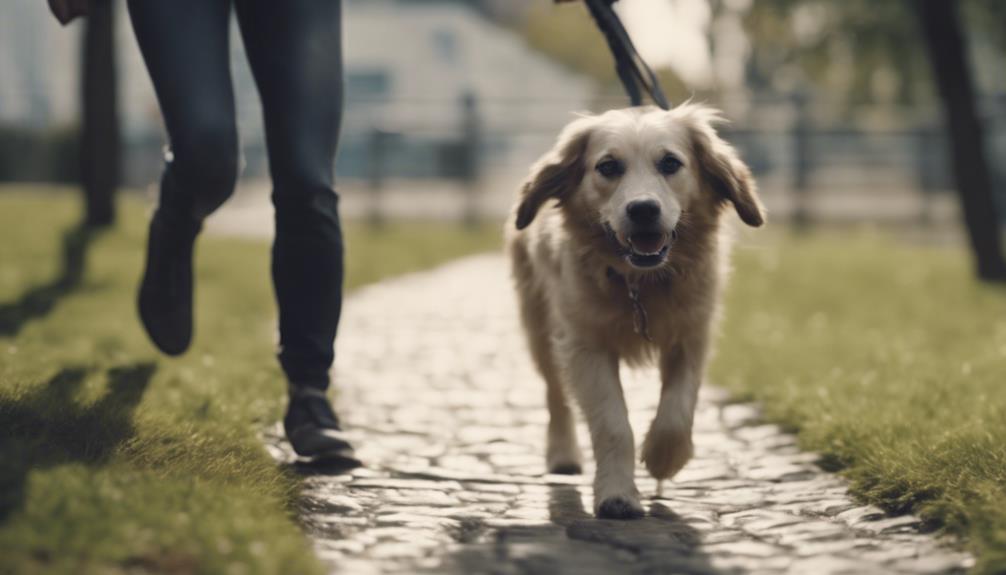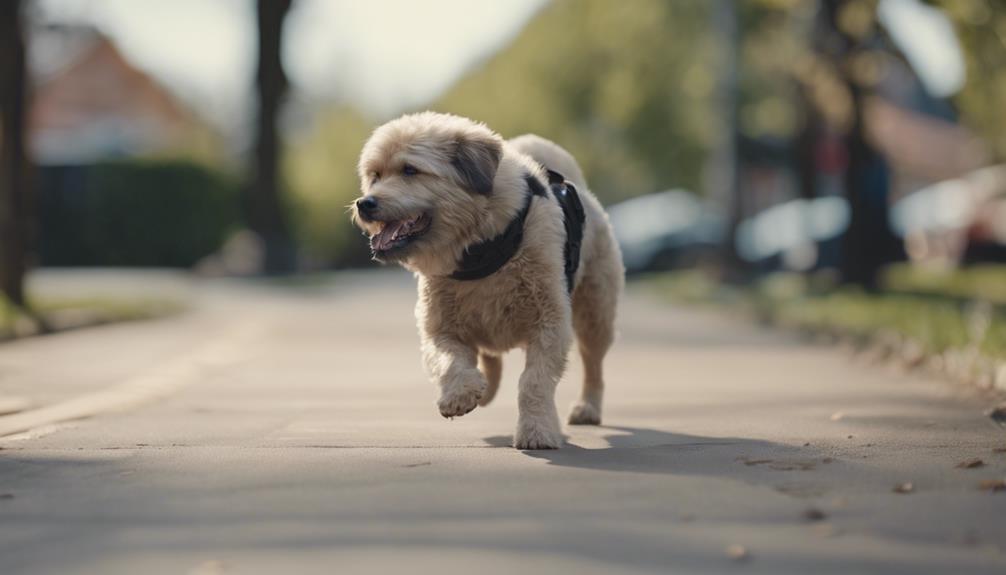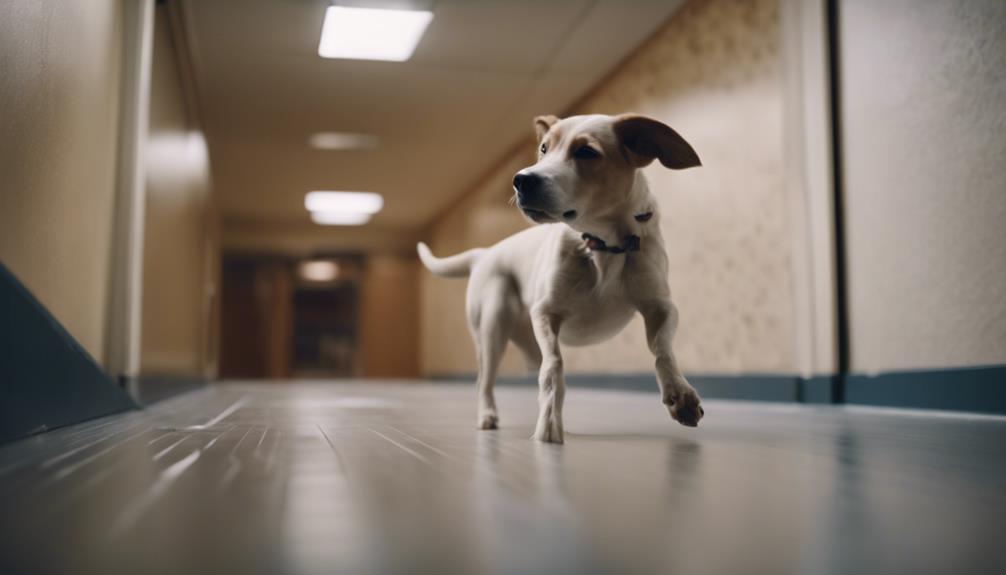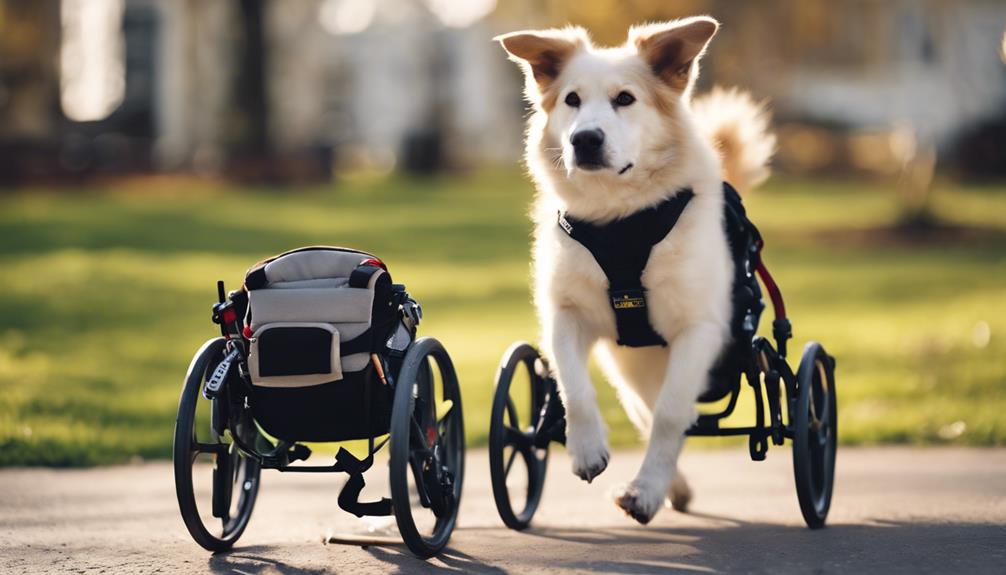Cerebellar hypoplasia in dogs is a complex neurological condition that presents unique challenges for both the affected animals and their caregivers. Understanding the underlying mechanisms of this disorder and the specific care requirements for dogs with cerebellar hypoplasia is essential in providing optimal support.
From tailored exercise regimens to environmental adjustments, a holistic approach to managing this condition can significantly improve the quality of life for these wobbly pups. By delving deeper into the nuances of cerebellar hypoplasia and exploring effective care strategies, dog owners can offer their furry companions the best possible outcomes in navigating this condition.
Key Takeaways
- Cerebellar hypoplasia affects balance and coordination in dogs.
- Supportive care improves quality of life for dogs with this condition.
- Early detection and management are crucial for the dog's well-being.
- Physical aids like harnesses and wagons assist in mobility for affected dogs.
Understanding Cerebellar Hypoplasia in Dogs
In the realm of veterinary neurology, a noteworthy condition that impacts dogs' cerebellar development is known as cerebellar hypoplasia. This neurological disorder results from underdevelopment of the cerebellum, a vital part of the brain responsible for coordination, balance, and muscle control in dogs.
Dogs affected by cerebellar hypoplasia often exhibit symptoms such as tremors, uncoordinated movements, and difficulties with basic motor skills like standing and walking. While there is no cure for this condition, supportive care can significantly improve the quality of life for affected dogs.
Understanding the challenges faced by dogs with cerebellar hypoplasia and providing appropriate care and accommodations tailored to their needs is crucial in ensuring their well-being and happiness.
Causes and Diagnosis of Canine Cerebellar Hypoplasia
Causes and Diagnosis of Canine Cerebellar Hypoplasia stem from factors such as incomplete cerebellum development during gestation or post-birth stages, genetic mutations prevalent in specific dog breeds, and maternal nutrition deficiencies or infectious diseases during pregnancy.
- Incomplete development of the cerebellum during gestation or post-birth.
- Genetic mutations in certain dog breeds like Airedale terriers and Boston terriers.
- Maternal nutrition deficiencies or infectious diseases during pregnancy.
- Infections such as canine distemper and toxin exposure can lead to cerebellar hypoplasia.
Veterinarians diagnose cerebellar hypoplasia through history, physical exams, and sometimes MRI scans to confirm the condition in affected dogs.
Signs and Treatment of Cerebellar Hypoplasia

Symptoms indicative of cerebellar hypoplasia in dogs encompass noticeable movement abnormalities and challenges with coordination. Dogs with this condition often display intention tremors, clumsiness, a wide stance, and limb tremors.
While the condition does not typically worsen over time, affected dogs may struggle with tasks like walking, running, and eating. Although there is no cure for cerebellar hypoplasia, supportive care plays a crucial role in enhancing the quality of life for these dogs.
Early detection and proper management are essential for ensuring the well-being of dogs with this neurological condition. By providing tailored support and understanding their unique needs, owners can help their wobbly pups adapt and lead fulfilling lives.
Caring for Dogs With Cerebellar Hypoplasia
Supporting dogs with cerebellar hypoplasia in their daily lives requires tailored care and understanding of their unique needs. When caring for dogs with this condition, consider the following:
- Adjust Living Environment: Modify the living space to accommodate their mobility challenges.
- Provide Physical Support: Utilize harnesses, wagons, or other aids to assist with movement.
- Prevent Falls: Limit access to areas where falls may occur and use non-slip mats.
- Understand Unique Requirements: Be attentive to their individual needs and provide the necessary care and attention.
Neurological Impact on Dogs' Mobility

Neurological conditions can significantly affect dogs' mobility, impacting their ability to move, balance, and coordinate movements effectively. When dogs experience neurological issues such as cerebellar hypoplasia, their coordination and balance are compromised, leading to challenges in walking, running, and even standing.
These conditions can manifest as tremors, exaggerated movements, and difficulty controlling their limbs. The impact on mobility can vary from mild to severe, depending on the extent of neurological impairment. Supportive care strategies, including physical aids like harnesses and wagons, can help improve mobility and prevent falls.
Understanding the specific mobility limitations of each affected dog is crucial in providing tailored care to enhance their quality of life.
Supportive Care Strategies for Affected Dogs
When addressing the care needs of dogs with cerebellar hypoplasia, implementing tailored supportive strategies can greatly enhance their quality of life and mobility. These supportive care strategies may include:
- Physical Support: Providing harnesses or wagons to assist in mobility.
- Environmental Modifications: Limiting access to certain areas and using non-slip mats to prevent falls.
- Specialized Nutrition: Tailoring the dog's diet to support their unique requirements.
- Emotional Support: Being patient, understanding, and meeting the dog's emotional needs.
Environmental Modifications for Safety

Implementing environmental modifications is crucial for ensuring the safety and well-being of dogs with cerebellar hypoplasia. To create a safe living space for a wobbly pup, consider removing obstacles and hazards that could cause tripping or falling. Non-slip mats or rugs can provide better traction for walking and standing.
Stairs should be gated off, and ramps or gentle slopes can be installed to help your dog navigate different levels in the house. Elevated food and water bowls can make eating and drinking easier for dogs with balance issues. Additionally, providing a comfortable and padded area for resting can prevent injuries in case of falls.
These modifications can significantly improve the quality of life for dogs with cerebellar hypoplasia.
Adapting Living Spaces for Wobbly Pups
To optimize the safety and comfort of dogs with cerebellar hypoplasia, adjustments to their living spaces are essential.
- Remove Obstacles: Clear pathways to prevent tripping hazards.
- Provide Soft Surfaces: Use rugs or foam mats to cushion falls.
- Secure Furniture: Anchor unstable items to avoid accidents.
- Create Safe Zones: Designate areas where the dog can move freely without obstacles.
Utilizing Assistive Devices for Assistance

Assisting dogs with cerebellar hypoplasia in navigating their surroundings effectively often involves the strategic use of assistive devices tailored to their specific needs. These devices can greatly improve the quality of life for these wobbly pups.
Harnesses and slings can provide stability and support during walks or when standing, helping to prevent falls. Mobility aids like wagons or carts can assist in moving around, especially for dogs with more severe mobility issues.
Additionally, non-slip mats can be placed in commonly used areas to prevent slipping and sliding. By utilizing these assistive devices, pet owners can help their canine companions with cerebellar hypoplasia lead more comfortable and independent lives.
Special Needs Considerations for Canine Companions
When caring for canine companions with special needs, it is crucial to tailor their environment and care routines to accommodate their unique requirements.
- Adapt the Living Space: Ensure the home is safe and accessible by removing obstacles and providing non-slip surfaces.
- Specialized Equipment: Consider using assistive devices like harnesses, slings, or carts to aid in mobility.
- Dietary Adjustments: Work with a veterinarian to create a diet plan that supports overall health and weight management.
- Consistent Routine: Establish a predictable daily routine to help the dog feel secure and reduce anxiety.
Enhancing Quality of Life Through Care

Canine companions with special needs, such as those with cerebellar hypoplasia, benefit greatly from tailored care strategies aimed at enhancing their quality of life through specialized support and accommodations.
Providing a safe and comfortable living environment is crucial for dogs with cerebellar hypoplasia. This can include using non-slip mats to prevent falls, limiting access to areas where injuries could occur, and creating a space that allows for easy movement.
Physical support like harnesses and wagons can assist these dogs in their mobility, making daily activities more manageable.
Additionally, being attentive to their unique requirements, offering patience and understanding, and providing consistent care and affection can significantly improve their overall well-being and happiness.
Importance of Early Detection and Management
Why is early detection and management crucial in addressing cerebellar hypoplasia in dogs?
Detecting cerebellar hypoplasia early on can significantly impact a dog's quality of life. Here are four reasons why early detection and management are essential:
- Timely Support: Early intervention allows for timely support and care strategies to be implemented.
- Prevention of Complications: Managing the condition from the outset can help prevent secondary health issues.
- Improved Adaptation: With early detection, dogs can adapt better to their symptoms and learn to navigate their environment.
- Enhanced Quality of Life: Proactive management enhances the overall quality of life for dogs with cerebellar hypoplasia.
Conclusion
In conclusion, cerebellar hypoplasia in dogs is a neurological condition that affects the development of the cerebellum, leading to challenges in balance, posture, and coordination.
While there is no cure for this condition, providing supportive care and making necessary adjustments can significantly improve the quality of life for affected dogs.
Understanding the causes, diagnosis, and appropriate care strategies is essential in ensuring the well-being of these special companions.




